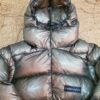The SDUL (super duper ultralight) series sweaters are currently the lightest we can make a down garment. They have the highest warmth to weight ratio and the highest fill weight to materials weight that can be achieved. They are down sweaters in the strictest sense. Like a knit sweater, no zippers, no pockets, no linings, no webbing, just insulation in the form of down in a nylon shell. The SDUL series uses 1000fp down and switches to a 7d shell fabric that weighs .49oz/yd2.
Fill type – 1000fp goose down
Approximate Fill weight (approximate) – NA
Approximate Total weight (approximate) – 5.2oz (small, hooded)
Approximate total weight with cords removed (approximate)- 5oz (small, hooded)
The goal with the SDUL 1.1 down sweater was to bridge the gap between the .75 and the 1.5 for true, average, 3 season use. It gets the same shell as the others but calculated loft is increased to 1.1. This is a solid, comfortable at freezing, 3 season jacket for the average person. Likely comfortable below freezing for many. It has a cinch at the neck and a cinch at the bottom hem to keep out drafts. Both cords are removable. An SDUL 1.1 has a lot of loft. One should plan on adding room for loft in the fit. When in doubt, oversize. A snug and fitted puffy is cold. A loose fitting puffy is warmer and usually ends up covering more of your body.
A puffy is most often used as an inactive layer for stops, at camp, or to help boost a sleep system. They don’t make for very good active layers since your sweat can easily compromise the down fill. This makes a zipper for ventilation a somewhat frivolous feature that can add a significant amount of weight and bulk. Pockets can be nice to have, but they often add a big chunk of weight and bulk and compromise the performance of a jacket by creating cold spots and by pulling insulation flat when there is weight in them. For those wanting pockets to warm hands I recommend adding a few inches to the sleeve to cover your hands. This is lighter than pockets and doesn’t compromise the overall warmth. All non-essential sewn through lines have been eliminated so the down can loft and cold spots are reduced. Simplicity and reduced weight and bulk are not the only benefits of all this. Leaving off many tedious features also reduces my labor and allows me to offer a very affordable jacket at an extremely low weight.
It’s meant to be used with a modular hood or head insulation, but can be built with an integrated hood on request.
More warmth out of less fill Sewn Through Baffle Construction and Its Effect on Warmth – Timmermade










Stephane Gauvin –
Excellent. Above expectations.
Medium size weighs 154g, and packs to 0.8L, perhaps even less but my compression sack can’t get any smaller. The description is conservative when it says “[…] comfortable at freezing, 3 season jacket for the average person. Likely comfortable below freezing for many.”. I took a walk today at -10c (14F) wearing the 1.1 over a light thermal base layer and was perfectly comfortable.